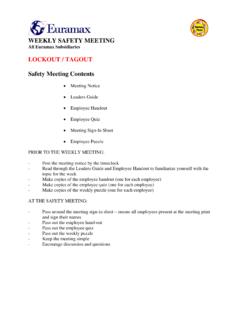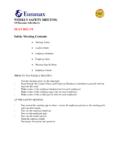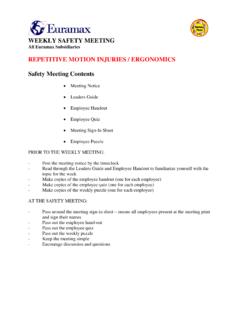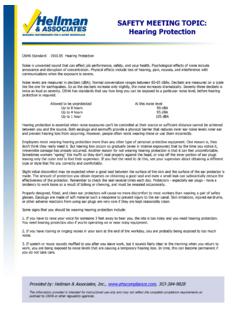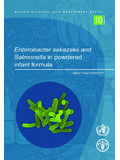Transcription of WEEKLY SAFETY MEETING COMBUSTIBLE DUST …
1 WEEKLY SAFETY MEETING . All Euramax Subsidiaries COMBUSTIBLE dust . SAFETY MEETING Contents MEETING Notice Leaders Guide Employee Handout Employee Quiz MEETING Sign-In Sheet Employee Puzzle PRIOR TO THE WEEKLY MEETING : - Post the MEETING notice by the timeclock - Read through the Leaders Guide and Employee Handout to familiarize yourself with the topic for the week - Make copies of the employee handout (one for each employee). - Make copies of the employee quiz (one for each employee). - Make copies of the WEEKLY puzzle (one for each employee). AT THE SAFETY MEETING : - Pass around the MEETING sign-in sheet ensure all employees present at the MEETING print and sign their names - Pass out the employee hand-out - Pass out the employee quiz - Pass out the WEEKLY puzzle - Keep the MEETING simple - Encourage discussion and questions WEEKLY SAFETY MEETING NOTICE.
2 THIS WEEK, OUR SAFETY MEETING WILL COVER. COMBUSTIBLE dust . TIME: _____. DATE: _____. PLACE: _____. WEEKLY SAFETY MEETING . All Euramax Subsidiaries COMBUSTIBLE dust . Leaders Guide EURAMAX PROCEDURE REFERENCE: None MEETING OBJECTIVE: COMBUSTIBLE dust has been a long-recognized hazard for American workers, and yet few specific regulations address the risks in a variety of occupational settings. This presentation will discuss recent COMBUSTIBLE dust incidents; risk factors that can lead to catastrophies; actions being taken by OSHA, Congress and the Chemical SAFETY Board to address these conditions; national consensus standards that can help employers proactively protect workers; and best practices.
3 For control of hazardous conditions. MEETING PREPARATION: Read the Euramax procedure, understand the contents, and ensure compliance. Use a flip chart during the discussion to write key points and employee responses. This technique visually reinforces your instruction. MATERIALS CHECKLIST: Flip chart and marking pens MEETING . INTRODUCTION. Any COMBUSTIBLE material (and some materials normally considered noncombustible) can burn rapidly when in a finely divided form. If such a dust is suspended in air in the right concentration, it can become explosive. The force from such an explosion can cause employee deaths, injuries, and destruction of entire buildings.
4 Such incidents have killed scores of employees and injured hundreds over the past few decades. Materials that may form COMBUSTIBLE dust include metals (such as aluminum and magnesium), wood, coal, plastics, biosolids, sugar, paper, soap, dried blood, and certain textiles. In many accidents, employers and employees were unaware that a hazard even existed. A COMBUSTIBLE dust explosion hazard may exist in a variety of industries, including: food ( , candy, sugar, spice, starch, flour, feed), grain, tobacco, plastics, wood, paper, pulp, rubber, furniture, textiles, pesticides, pharmaceuticals, dyes, coal, metals ( , aluminum, chromium, iron, magnesium, and zinc), and fossil fuel power generation.
5 Page 1. WEEKLY SAFETY MEETING . All Euramax Subsidiaries COMBUSTIBLE dust . Leaders Guide Here are some examples of COMBUSTIBLE dust explosions in the : Organic dust Fire and Explosion: Massachusetts (3 killed, 9 injured). In February 1999, a deadly fire and explosion occurred in a foundry in Massachusetts. The Occupational SAFETY Health Administration (OSHA) and state and local officials conducted a joint investigation of this incident. The joint investigation report indicated that a fire initiated in a shell molding machine from an unknown source and then extended into the ventilation system ducts by feeding on heavy deposits of resin dust .
6 A small primary deflagration occurred within the ductwork, dislodging dust that had settled on the exterior of the ducts. The ensuing dust cloud provided fuel for a secondary explosion which was powerful enough to lift the roof and cause wall failures. Organic dust Fire and Explosion: North Carolina (6 killed, 38 injured). In January 2003, devastating fires and explosions destroyed a North Carolina pharmaceutical plant that manufactured rubber drug-delivery components. Six employees were killed and 38. people, including two firefighters, were injured. The U. S. Chemical SAFETY and Hazard Investigation Board (CSB), concluded that an accumulation of a COMBUSTIBLE polyethylene dust above the suspended ceilings fueled the explosion.
7 The CSB was unable to determine that ignited the initial fire or how the dust was dispersed to create the explosive cloud in the hidden ceiling space. The explosion severely damaged the plant and caused minor damage to nearby businesses, a home, and a school. Organic dust Fire and Explosion: Kentucky (7 killed, 37 injured). In February 2003, a Kentucky acoustics insulation manufacturing plant was the site of another fatal dust explosion. The CSB also investigated this incident. Their report cited the likely ignition scenario as a small fire extending from an unattended oven which ignited a dust cloud created by nearby line cleaning.
8 This was followed by a deadly cascade of dust explosions throughout the plant. Metal dust Fire and Explosion: Indiana (1 killed, 1 injured). Finely dispersed airborne metallic dust can also be explosive when confined in a vessel or building. In October 2003, an Indiana plant where auto wheels were machined experienced an incident which was investigated by CSB. A CSB news release told a story similar to the previously discussed organic dust incidents: aluminum dust was involved in a primary explosion near a chip melting furnace, followed by a secondary blast in dust collection equipment. Page 2. WEEKLY SAFETY MEETING . All Euramax Subsidiaries COMBUSTIBLE dust .
9 Leaders Guide DISCUSSION GUIDE. Question: What is COMBUSTIBLE dust ? Answer: COMBUSTIBLE dust is finely divided solid material that is 420 microns or less in diameter and which, when dispersed in air in the proper proportions, could be ignited by a flame, spark, or other source of ignition. Question: What creates COMBUSTIBLE dust ? Answer: COMBUSTIBLE dusts, is fine particles that ignite when suspended in air. COMBUSTIBLE dust comes from many sources, including sugar, flour, feed, plastics, wood, rubber, textiles, pesticides, pharmaceuticals, dyes, coal, and metals. Question: How do you prevent COMBUSTIBLE dust explosions? Answer: One of the best ways to prevent these explosions is to minimize dust accumulations.
10 Ensuring good housekeeping, designing and maintaining equipment to prevent dust leaks, using dust collectors, eliminating flat surfaces and areas where dust can accumulate and sealing hard to clean areas (such as the area above a suspended ceiling) can effectively prevent or at least minimize the severity of flash fires and dust explosions. Question: What four basic elements are needed for dust to explode? Answer: COMBUSTIBLE dust (fuel). Ignition source (heat). Oxygen in air (oxidizer). Enclosed area for explosive pressure to build. SUMMARY: Since 1980, more than 130 workers were killed and more than 780 injured in COMBUSTIBLE dust explosions, according to OSHA.

